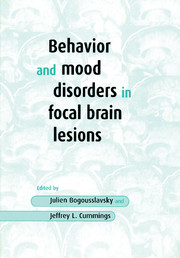Book contents
- Frontmatter
- Dedication
- Contents
- List of contributors
- Preface
- Acknowledgments
- 1 Emotional consequences of focal brain lesions: an overview
- 2 The evaluation of mood and behavior in patients with focal brain lesions
- 3 Methodological issues in studying secondary mood disorders
- 4 Emotional behavior in acute brain lesions
- 5 Depression and lesion location in stroke
- 6 Mood and behavior in disorders of the basal ganglia
- 7 Mania and manic-like disorders
- 8 Behavioral and emotional changes after focal frontal lobe damage
- 9 Disorders of motivation
- 10 Thalamic behavioral syndromes
- 11 Obsessive-compulsive disorders in association with focal brain lesions
- 12 Emotional dysprosody and similar dysfunctions
- 13 Temporal lobe behavioral syndromes
- 14 Neural correlates of violent behavior
- 15 Focal lesions and psychosis
- 16 Alterations in sexual behavior following focal brain injury
- 17 Anosognosia
- 18 Acute confusional states and delirium
- Index
5 - Depression and lesion location in stroke
Published online by Cambridge University Press: 05 August 2016
- Frontmatter
- Dedication
- Contents
- List of contributors
- Preface
- Acknowledgments
- 1 Emotional consequences of focal brain lesions: an overview
- 2 The evaluation of mood and behavior in patients with focal brain lesions
- 3 Methodological issues in studying secondary mood disorders
- 4 Emotional behavior in acute brain lesions
- 5 Depression and lesion location in stroke
- 6 Mood and behavior in disorders of the basal ganglia
- 7 Mania and manic-like disorders
- 8 Behavioral and emotional changes after focal frontal lobe damage
- 9 Disorders of motivation
- 10 Thalamic behavioral syndromes
- 11 Obsessive-compulsive disorders in association with focal brain lesions
- 12 Emotional dysprosody and similar dysfunctions
- 13 Temporal lobe behavioral syndromes
- 14 Neural correlates of violent behavior
- 15 Focal lesions and psychosis
- 16 Alterations in sexual behavior following focal brain injury
- 17 Anosognosia
- 18 Acute confusional states and delirium
- Index
Summary
Introduction
The relationship between depressive disorder and lesion location has been, perhaps, the most controversial area of research in the field of post-stroke mood disorders. Although the association between specific clinical symptomatology and lesion location is one of the fundamental goals of clinical practice in neurology, this has rarely been the case with psychiatric disorders. Cognitive functions such as visual spatial reasoning, auditory comprehension, speech production, and extent and severity of motor or sensory impairment are all symptoms of stroke which are commonly used by clinicians to localize lesions to particular brain regions. There is, however, no known neuropathology consistently associated with primary mood disorders (i.e., mood disorders not associated with a physical illness), and, even among secondary mood disorders (i.e., mood disorders associated with a physical illness) the idea that there maybe a focal neuropathology associated with the development of major depression has led to both surprise and skepticism.
Our finding of a clinical-pathological correlation between the severity of depression, as measured by depression rating scales, and the distance of the lesion from the frontal pole on a computerized tomography (CT) scan image, as measured by the distance in millimeters between the anterior border of the lesion and the frontal pole, was first reported in 1981 by Robinson and Szetela. We reported an inverse correlation between the overall severity of depressive symptoms, determined by combining three depression rating scales, and the distance of the anterior border of the lesion from the frontal pole normalized to the overall anterior to posterior length of the brain. Since then, this finding has turned out to be one of the most robust and consistently replicated clinical — pathological correlations reported in psychiatry. This phenomenon is discussed in greater detail in the section on the relationship between depression and anterior-posterior lesion location, but the ability to study the relationship between symptomatology and lesion location is one of the benefits of studying mood disorders in patients with stroke lesions. Because studies of patients with primary mood disorders have not been able to associate clinical symptoms with focal neuropathology, utilizing patients with known neuropathological disorders to examine potential clinical-pathological relationships in mood disorders may provide more insights than are possible with studies of primary disorders.
- Type
- Chapter
- Information
- Behavior and Mood Disorders in Focal Brain Lesions , pp. 95 - 121Publisher: Cambridge University PressPrint publication year: 2000
- 1
- Cited by



